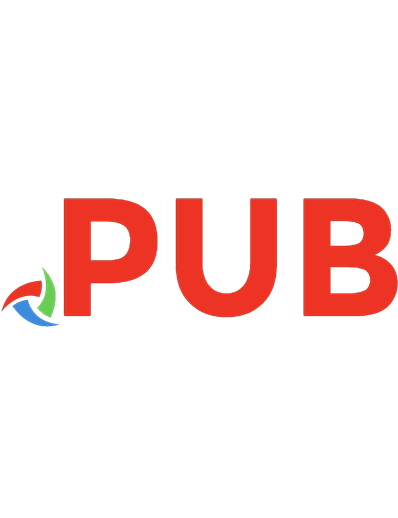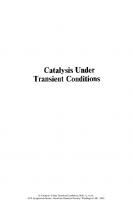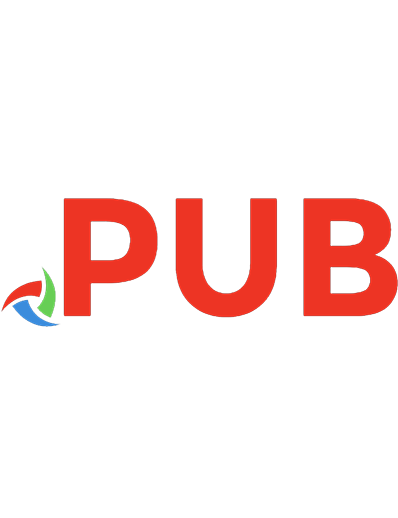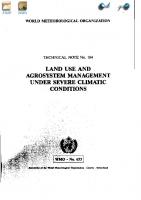Land Use and Agrosystem Management under Severe Climatic Conditions
195 41 3MB
English Pages [177]
Polecaj historie
Citation preview
START
INDEX
START
INDEX
START
INDEX
START
INDEX
START
INDEX CONTENTS
Page
Foreword .. ... .. ... .. ....... ... .......... ... .. .. ... . ..................... Summary (English, French, Russian, Spanish)
.. .. ... . .....................
VII IX
Chapter 1 - INTRODUCTION (J.J. Burgos, W. Baier) 1.1 The spread of agriculture into climatically marginal regions . . 1.2 The relativity of climatic severity ........................... 1.3 General features of regions with severe climatic constraints . . 1.4 Transformation of biomes and ecosystems into agrosystems ...... 1.5 Climate and climatic variability .............................. 1.5.1 Introduction .................................................. 1.5.2 Climatic systems ................................. ..-A.- ....... 1.5.3 Former climates .............................................. 1.6 Climatic variability and land use ............................. References .............................................................
1 2 3 4 7 7 7 8 9 11
Chapter 2 - EQUILIBRIUM AND EXTREME CLIMATIC CONDITIONS OF THE WORLD'S BIOMES AND AGROSYSTEMS (J.J. Burgos) 2.1 2.2
General considerations ........................................ Potential primary productivity and potential crop productivity .................................................. 2.2.1 Potential primary productivity ................................ 2.2.1.1 Absolute potential productivity ............................... 2.2.1.2 To date potential productivity (TPP) .......................... 2.2.1.3 Actual productivity (API ...................................... 2.2.2 Potential crop production ..................................... 2.2.3 Soil and climatic characteristics in evaluating potential crop production ..................................... 2.3 Climatic resources for agriculture ............................ 2.4 Climatic models for natural vegetation and major groups of soils ...................................................... 2.4.1 Climatic models for the large natural formations of vegetation (phytoclimatic models) ............................. 2.4.2 Climatic models for the great soil groups (edaphoclimatic models) ....................................... 2.4.3 Verification of the phytoclimatic and edaphoclimatic models ........................................................ 2.5 Agrosystems, their stability and extreme conditions ........... 2.5.1 Agrosystems of interest in teaching and geography ............. 2.5.2 Agrosystems of interest in the planning of land use ........... 2.5.3 Agrosystems of interest in the improvement of farm production and management ..................................... References .. .. ......... ... ... ..... .. ... .. .... ...... .. .. ......... .. . . .. ..
23 23 27 28 40 43 44
IV START
INDEX
CONTENTS
Page
Chapter 3 - LAND USE AND AGROSYSTEM MANAGEKENT IN ARID CONDITIONS (F. Mattei, M. F&e, T. Ionesco) Arid zones and civilization ................................... Classification of arid zones .................................. Main constraints due to aridity ............................... Irrigated agriculture ......................................... Runoff farming and other traditional methods for improving water availability ............................................ Agriculture under controlled or semi-controlled environments .. 3.6 Pastoralism and cattle rearing ................................ 3.7 Meteorological and climatological information required to 3.8 improve agriculture and livestock production .................. References ..............................................................
3.1 3.2 3.3 3.4 3.5
57 57 58 60 61 63 64 66 67
Chapter 4 - LAND USE AND AGROSYSTEM MANAGEMENT IN SEMI-ARID CONDITIONS (G.D.V. Williams) The definition and geographic distribution of semi-arid lands ......................................................... Meteorological conditions and human response .................. 4.2 Dryland farming in cold and temperate regions ................. 4.2.1 Farming in the semi-arid tropics .............................. 4.2.2 Livestock production in semi-arid regions ..................... 4.2.3 Irrigation .................................................... 4.2.4 Environmental problems ........................................ 4.3 Use of weather and climatic data to improve agrosystem 4.4 management and land use ....................................... References .............................................................. Bibliography ............................................................ 4.1
Chapter 5 - LAND USE AND AGROSYSTEM MANAGEMENT IN EXTREME MONSOON REGIONS W.P. Subrahmanyam) Climatological parameters characterizing the monsoon regions ................................*...................... Meteorological effects on agrosystems and land management ..... 5.2 Crop management in monsoon regions ............................ 5.2.1 Land and water management ..................................... 5.2.2 Soil erosion and degradation .................................. 5.2.3 Livestock breeding and management in monsoon regions .......... 5.3 Meteorological and climatological information needed to 5.4 improve monsoon agrosystem management and land use ............ References ..............................................................
5.1
91 94 94 98 99 100 102 110
START
INDEX
CONTENTS
V
Page
Chapter 6 - LAND USE AND AGROSYSTEM MANAGEMENT IN THE HUMID TROPICS (L.C.B. Molion) Introduction .................................................. Macroscale characteristics of humid tropics ................... Land-use systems in the humid tropics ......................... The energy and water balances in the humid tropics ............ The energy balance ............................................ The hydrological balance ...................................... The surface hydrological balance .............................. The atmospheric hydrological balance .......................... The hydrological cycle components and land-use systems ........ Concluding remarks on energy and water balances ............... Cultivation under shade ....................................... Flood-plain agriculture ....................................... Flood-plain grazing of livestock .............................. Soil erosion and degradation .................................. Meteorological information needed to improve agrosystem management and land use in the humid tropics .................. Microscale information ........................................ 6.7.1 Meso- and macroscale (synoptic) information ................... 6.7.2 Suggestions for implementing networks ......................... 6.7.3 References ...... .. ... ... .. .. ..... ...... ... ... .. ...... ...... .. ... ... .. .. . 6.1 6.1.1 6.1.2 6.2 6.2.1 6.2.2 6.2.2.1 6.2.2.2 6.2.2.3 6.2.3 6.3 6.4 6.5 6.6 6.7
114 114 118 118 119 122 122 123 123 125 126 129 129 131 133 133 134 134 135
Chapter 7 - LAND USE AND AGROSYSTEM MANAGEMENT IN COLD REGIONS (G.D.V. Williams) The definition and geographic distribution of cold regions .. .. ... .. .. .. .. .......... .. ......... ...... .. ..... ... .. . Crop production in circumpolar regions ........... .. ..... ... ... 7.2 Crop production in tropical highlands ............ ..... .. ... ... 7.3 7.4 Cold dry regions .............................................. 7.5 Livestock management .......................................... Shelters, farm structures and roads ........ ........ ... .. ... .. . 7.6 7.7 Crops under plastic or glass . ...... .. ...... ........ ..... ... .. . Use of agroclimatic data to improve agrosystem management 7.0 and land use .. .. .. ............ .. ... .. ... ... ........ ... .. ... .. . 7.9 Use of weather and climate forecasts to improve agrosystem management and land use .... ..... ... ... .. .... .. ...... .. ... .. .. . References .............................................................. Bibliography ............................................................ 7.1
138 141 142 143 144 147 148 151 154 156 160
START
INDEX
START
INDEX
START
INDEX
START
INDEX
START
INDEX
START
INDEX
START
INDEX
START
INDEX
START
INDEX
START
INDEX
START
INDEX
START
INDEX
START
INDEX
START
INDEX
START
INDEX
START
INDEX
START
INDEX
START
INDEX
START
INDEX
START
INDEX
START
INDEX
START
INDEX
START
INDEX
START
INDEX
START
INDEX
START
INDEX
START
INDEX
START
INDEX
START
INDEX
START
INDEX
START
INDEX
START
INDEX
START
INDEX
START
INDEX
START
INDEX
START
INDEX
START
INDEX
START
INDEX
START
INDEX
START
INDEX
START
INDEX
START
INDEX
START
INDEX
START
INDEX
START
INDEX
START
INDEX
START
INDEX
START
INDEX
START
INDEX
START
INDEX
START
INDEX
START
INDEX
START
INDEX
START
INDEX
START
INDEX
START
INDEX
START
INDEX
START
INDEX
START
INDEX
START
INDEX
START
INDEX
START
INDEX
START
INDEX
START
INDEX
START
INDEX
START
INDEX
START
INDEX
START
INDEX
START
INDEX
START
INDEX
START
INDEX
START
INDEX
START
INDEX
START
INDEX
START
INDEX
START
INDEX
START
INDEX
START
INDEX
START
INDEX
START
INDEX
START
INDEX
START
INDEX
START
INDEX
START
INDEX
START
INDEX
START
INDEX
START
INDEX
START
INDEX
START
INDEX
START
INDEX
START
INDEX
START
INDEX
START
INDEX
START
INDEX
START
INDEX
START
INDEX
START
INDEX
START
INDEX
START
INDEX
START
INDEX
START
INDEX
START
INDEX
START
INDEX
START
INDEX
START
INDEX
START
INDEX
START
INDEX
START
INDEX
START
INDEX
START
INDEX
START
INDEX
START
INDEX
START
INDEX
START
INDEX
START
INDEX
START
INDEX
START
INDEX
START
INDEX
START
INDEX
START
INDEX
START
INDEX
START
INDEX
START
INDEX
START
INDEX
START
INDEX
START
INDEX
START
INDEX
START
INDEX
START
INDEX
START
INDEX
START
INDEX
START
INDEX
START
INDEX
START
INDEX
START
INDEX
START
INDEX
START
INDEX
START
INDEX
START
INDEX
START
INDEX
START
INDEX
START
INDEX
START
INDEX
START
INDEX
START
INDEX
START
INDEX
START
INDEX
START
INDEX
START
INDEX
START
INDEX
START
INDEX
START
INDEX
START
INDEX
START
INDEX
START
INDEX
START
INDEX
START
INDEX
START
INDEX
START
INDEX
START
INDEX
START
INDEX
START
INDEX
START
INDEX
START
INDEX
START
INDEX
START
INDEX
START
INDEX
START
INDEX
START
INDEX
START
INDEX



![Environmental Land Use Planning and Management [Second ed.]
1597267309, 9781597267304](https://dokumen.pub/img/200x200/environmental-land-use-planning-and-management-secondnbsped-1597267309-9781597267304.jpg)






